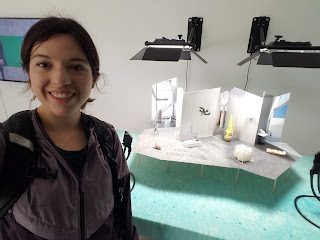Unit 8: NanoTech + Art
It is typically said that people fear what they do not understand. With nanotechnology, such a statement can be applied especially when the subject in question cannot be seen with the naked eye. Today, much discomfort towards the field of nanotechnology exists. In The Nanomeme Syndrome, it is said that "as soon as we confront the scale that nanotechnology works within, our minds short circuit. The scale becomes too abstract in relation to human experience. Consequently, any intellectual connection to the nanoscale becomes extremely difficult" (Gimzewski and Vesna). However, nanotechnology has surprisingly made life-sized impacts in its small ways. In his lecture, Dr. Jim Gimzewski mentions several everyday products that utilize nanotechnology: medicine therapy/treatment, makeup, self-cleaning windows, silver odor-eliminating clothing, etc. (Lecture 3).
Of course, these innovative products would not have been able to come into existence without extensive research. The Scanning Tunneling Microscope (STM) was one of the greater discoveries for nanotechnology. It works very similar to the way we touch objects; an atom-sharp tip scans over nano-sized items and sends the data to be rendered into an image. Upon editing, a beautiful, simple-to-understand photo is created (Gimzewski, Lecture 2). This technology, along with others such as micro-scaled electric motors and very tiny books, are not that different from what we experience as humans. Classical mechanics may no longer preside at the nano-level, but the methods and ways of analyses are nothing to be afraid of by the general population because they are still so familiar. If anything, nanotechnology is an extension of human experience in which we happen to make new discoveries. Gimzewski and Vesna agree with this view in the following statement of their article: "Both nanotechnology and media arts, by their very nature, have a common ground in addressing the issues of manipulation, particularly sensory perception, questioning our reaction, changing the way we think. They are complementary..."
Sources
Gimzewski, Jim. “Nanotechnology + Art.” Lecture 2. <https://cole2.uconline.edu/courses/888567/pages/unit-8-view?module_item_id=16300827>.
Gimzewski, Jim. “Nanotechnology + Art.” Lecture 3. <https://cole2.uconline.edu/courses/888567/pages/unit-8-view?module_item_id=16300827>.
Gimzewski, Jim, and Victoria Vesna. The Nanomeme Syndrome: Blurring of Fact and Fiction in the Construction of a New Science. Print.
Kim, CJ. “Research.” Micro and Nano Manufacturing Lab, cjmems.seas.ucla.edu/research/.
“Nano Technology- Products, and Applications.” TutorialsWeb, www.tutorialsweb.com/nanotech/page-10.htm.
“Silver Nanoparticles: A Valuable Weapon in Microbial Warfare.” Illumin, illumin.usc.edu/244/silver-nanoparticles-a-valuable-weapon-in-microbial-warfare/.
| Silver Nanoparticles Fighting against Smelly Bacteria |
Of course, these innovative products would not have been able to come into existence without extensive research. The Scanning Tunneling Microscope (STM) was one of the greater discoveries for nanotechnology. It works very similar to the way we touch objects; an atom-sharp tip scans over nano-sized items and sends the data to be rendered into an image. Upon editing, a beautiful, simple-to-understand photo is created (Gimzewski, Lecture 2). This technology, along with others such as micro-scaled electric motors and very tiny books, are not that different from what we experience as humans. Classical mechanics may no longer preside at the nano-level, but the methods and ways of analyses are nothing to be afraid of by the general population because they are still so familiar. If anything, nanotechnology is an extension of human experience in which we happen to make new discoveries. Gimzewski and Vesna agree with this view in the following statement of their article: "Both nanotechnology and media arts, by their very nature, have a common ground in addressing the issues of manipulation, particularly sensory perception, questioning our reaction, changing the way we think. They are complementary..."
 |
| Nano-scaled Red Blood Cell Retriever |
I have encountered the benefits of nanotechnology through my own studies at UCLA as well. As a Mechanical Engineering student, I have taken a course on manufacturing, which covers the topics of nano-scaled products. Professor CJ Kim shared with the class one of his works of nanotechnology: a microscopic hand that opens and closes using "fingers" like ours. This is yet another example of how science is scaling human experience into smaller realms for new, exciting, and even artistic benefits for the future.
 |
| Prof. CJ Kim's Microhand |
Sources
Gimzewski, Jim. “Nanotechnology + Art.” Lecture 2. <https://cole2.uconline.edu/courses/888567/pages/unit-8-view?module_item_id=16300827>.
Gimzewski, Jim. “Nanotechnology + Art.” Lecture 3. <https://cole2.uconline.edu/courses/888567/pages/unit-8-view?module_item_id=16300827>.
Gimzewski, Jim, and Victoria Vesna. The Nanomeme Syndrome: Blurring of Fact and Fiction in the Construction of a New Science. Print.
Kim, CJ. “Research.” Micro and Nano Manufacturing Lab, cjmems.seas.ucla.edu/research/.
“Nano Technology- Products, and Applications.” TutorialsWeb, www.tutorialsweb.com/nanotech/page-10.htm.
“Silver Nanoparticles: A Valuable Weapon in Microbial Warfare.” Illumin, illumin.usc.edu/244/silver-nanoparticles-a-valuable-weapon-in-microbial-warfare/.


I really liked the examples you used to understand nanotechnology. I also found the application to medicine very interesting and exciting, like the nano scaled red blood cell retriever.
ReplyDeleteThis is a very strong post! I really liked your incorporation of medicine and nanotechnology. It is really cool to see how technology is changing with new discoveries like nanotechnology
ReplyDelete